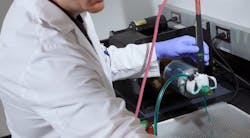Back to the future — sustainability and selective electroplating
The petrochemical industry is reeling from a succession of challenges, including COVID-19 and a changing world view on fossil fuels and plastic. As a result, the sector is seeking more sustainable and cost-effective ways to manage operations, and maintenance is under the spotlight. Here, Tony Arana, Southwest Sales Manager at SIFCO ASC, looks at how the industry can future-proof its activities — by looking back to a long-established but underused technology: selective electroplating.
Right now, the petrochemical industry is being hit from all sides.
First, as an industry of peaks and troughs, it was already entering a downcycle. Then along came COVID-19, impacting transport and sales. There are other factors, too, and not least is the growing awareness of the environmental damage caused by petrochemically produced plastics, with public pressure and legislation demanding dramatic cuts in its manufacture and use. So much so that the New Plastics Economy Global Commitment has been signed by 250 organizations which together account for 20% of the world’s plastic packaging.
To compound these problems, billions of dollars have already been committed to new refineries and processing plants. In Texas, for example, approximately $120 billion was invested in new facilities between 2014 and 2019. It’s a similar story in Asia and the Middle East.
With this "perfect storm" of slow demand and surplus capacity, the sector faces significant financial challenges, with a few pessimistic commentators predicting a major fall-out within five years. Although some petrochemicals — including ethylene and propylene — are likely to enjoy continued growth, the overall picture is extremely challenging and petrochemical companies are being forced to find efficiencies wherever they can.
This has brought an ever-greater focus onto maintenance activities. Always important, it is now become more critical than ever.
A relentless drive for productivity
There is no doubt that effective planned maintenance can help minimize downtime and drive productivity improvements. Businesses need to optimize time and resources, so they are paying more attention to the techniques and methods of repair. Anything which can deliver quality results, reliably and cost-effectively needs to be considered — which is bringing selective electroplating into the frame.
Though this is a long-established technology which has been delivering benefits in demanding environments — including aerospace, military and oil and gas applications — for more than 50 years, it has largely been superseded by other repair methods in the petrochemical industry.
Today, however, businesses are rediscovering its unique value which includes speed, portability and high-quality performance. Selective — or brush plating as it is otherwise known — can be applied in situ and is therefore ideal for speedy repairs and for components with complex geometries. The deposits are capable of withstanding the petrochemical industry’s extreme operating conditions, making it an invaluable addition to any maintenance program.
Selective plating — the technology
Selective electroplating uses basic electrochemical principles. An electrolyte solution containing ions of the depositing metal is introduced between the negatively charged part to be plated and the positively charged plating tool, or anode. Direct current is applied via a portable power-supply, giving the user direct and precise control over amperage, voltage and plating time. The circuit is completed when the anode makes contact with the surface of the part that is being plated.
Key design features on the tool (commonly known as the anode) ensure that the electrolyte is evenly distributed. The end result is a dense and well-adhered metal deposit. Moreover, the technology allows for a choice of more than 50 metal or alloy solutions, meaning that applications can be customized to specific characteristics. For example, where parts are mis-machined or badly scored, copper can be used to build the part back up, while nickel can be used to provide protection against wear or corrosion from chemicals or steam.
Selective electroplating owes its longevity, and its recent resurgence, to a number of factors.
The versatility factor
Selective electroplating is a highly versatile technology. As well as being able to quickly bring inside and outside diameters back to size, it can be used to repair very localized defects while equipment is still in situ. A wear- or corrosion-resistance coating can be applied precisely where it is needed, eliminating the delays and downtime caused by having to disassemble the equipment and tank plate the entire part.
Typical petrochemical applications for selective electroplating include defect repair and corrosion protection, and pre-brazing and anti-galling, as well as improving hardness and wear resistance. It is especially useful for applications such as compressors, valves and casings for turbines and pumps.
The quality factor
Delivered by skilled and fully trained technicians, selective electroplating provides deep and strong molecular bonds between the substrate and coating. Research shows that this is superior to both thermal spray and metal-filled epoxy coatings.
These two technologies have a different form of bond — mechanical, in the case of spray coatings, and a form of "glue" in the case of epoxy. These coatings typically achieve an adhesion factor of between 1,500-5,000 psi. Adhesion tests indicate that selective electroplated deposits achieve in excess of 10,000 psi. This, together with a range of approvals including the AMS 2451 and MIL-STD-865_D standards, provides the quality assurance that maintenance professionals demand.
The reliability factor
Selective electroplating also delivers against another key requirement of maintenance professionals — reliability. By being able to make repairs or enhance the corrosion resistance of specific parts without needing to remove them, operators can keep equipment running between scheduled downtimes.
The cost-saving factor
Selective electroplating has also proved itself to be an exceptionally cost-effective technology, not least because it is portable. In essence, you take the solution to the part, instead of having to take the part off the machine and send it away for repair, with turnaround often taking place within a working day.
For high volume requirements, the process can even be automated to deliver further productivity improvements. Importantly, as repairs are carried out on working parts, there is a reduced need for pre- and post-machining, as the deposit can be plated to size. All of these factors deliver significant cost benefit without compromising on quality.
A case study — cost-effective defect repair
One of our customers was experiencing scoring damage on the spindle of a gate valve, with defects ranging between 0.060 inches wide by 0.030 inches deep to 6-8 inches long. Replacing each spindle would cost $8,000, so repair was the preferred option. However, the customer was being quoted repair lead times of around 10 weeks, with an additional need to obtain nuclear certification.
Selective electroplating provided a far more effective solution. We dressed the spindle back up with a Dremel, before restoring the scoring to its original dimension by selectively plating with copper. We then capped this with a special nickel sulfamate deposit to provide additional wear and corrosion resistance. This was completed within seven hours — a single working shift — saving significant time and money.
A sustainable technology, supporting CSR commitments
One final benefit of selective electroplating lies in the issue of sustainability — a big focus for the petrochemical industry. Data published by the World Bank’s Global Gas Flaring Reduction (GGFR) program indicates that gas flaring releases around 145 billion cubic meters into the atmosphere — the equivalent of 270 million tons of CO2 emissions.
Even a short period of unplanned downtime can therefore have an environmental impact, and so petrochemical companies are under pressure to restore operations quickly. Selective electroplating has an important contribution to make in this respect.
In addition, selective plating uses fewer chemicals than other processes, and generates very little wastewater. And its portability reduces the emissions and costs associated with the shipping of parts for repair, as is necessary with tank plating. In its own way, brush plating technology is designed to minimize toxic or hazardous waste and emissions.
Tried, tested and trusted
In summary, the petrochemical industry is facing an unprecedented period of upheaval as the world’s focus shifts away from fossil fuels and plastics, and onto more sustainable solutions.
Faced with increasing legislative scrutiny and pressure on productivity and profit margins, petrochemical companies need to drive efficiencies in every area of their work. With strong and proven capabilities in sustainability, cost-saving and quality, selective electroplating is a tried and tested technology that can help the industry address these challenges with confidence and quality.
Tony Arana is southwest sales manager at SIFCO ASC. SIFCO ASC is a global leader in selective plating solutions. A Quaker Houghton company, SIFCO ASC provides practical, cost-effective selective brush plating solutions to improve part performance and reduce manufacturing costs through corrosion protection, increased wear resistance, increased hardness, improved conductivity, anti-galling or slip. Visit www.sifcoasc.com to find out more.

